While there are great flowchart makers for Windows and other platforms, sometimes an online, web-based solution is best. That’s because these don’t need a specific hardware configuration or operating system to work—all you need is a web browser.
Here are some of the best online flowchart makers that you can use for free or at an affordable price.
1. Lucidchart
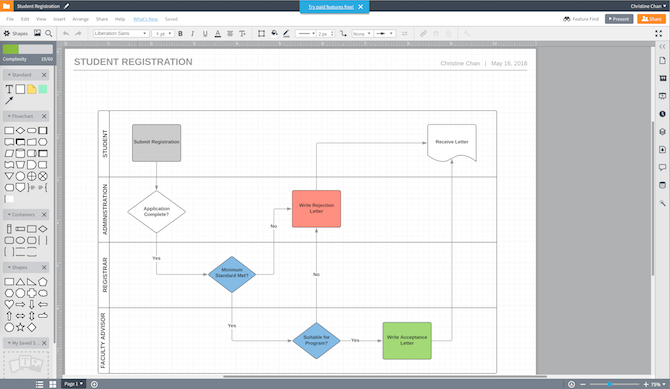
When it comes to these diagrams, Lucidchart is one of the best and most reliable online flowchart makers available.
The fast and fluid drag and drop interface makes it easy to create and manage flowcharts. There are pre-made templates to choose from, or you can start with a fresh blank canvas. Even free accounts get access to basic shapes, arrows, and text boxes. That is enough to get started.
Collaboration is also available for the free tier. But there are some limitations. For example, a Team user can collaborate with a Free user, but the Free user can only edit if it has 60 or fewer objects and if there aren’t any paid-level objects in it.
You can save Lucidchart documents in multiple formats. Lucidchart supports JPEG, PDF, PNG, SVG, and Visio (VDX) formats. There’s even support for importing from Amazon Web Service (AWS), Visio (VSDX), Omnigraffle, and more. And if you need to finish a flowchart later, all of your data gets stored in their cloud, so you just pick up where you left off.
Lucidchart has a free basic account tier, as well as paid plans starting at $5.95 per month for Home, $8.95 for Pro, and $20 for Team. The paid options provide more features such as more storage, unlimited shapes and documents, data linking, Microsoft Visio import, and more. If you stick with a free account, you get 25MB of storage and up to five documents.
Lucidchart is an excellent option to consider if you are looking for an alternative flowchart creator to Visio. It’s accessible from any device with a web browser, has a streamlined and intuitive design, and is affordable.
Lucidchart Is the Visio Alternative You've Been Waiting For Lucidchart Is the Visio Alternative You've Been Waiting For You might not have heard of Lucidchart before, but I bet you've heard of Microsoft Visio. Read More
2. draw.io
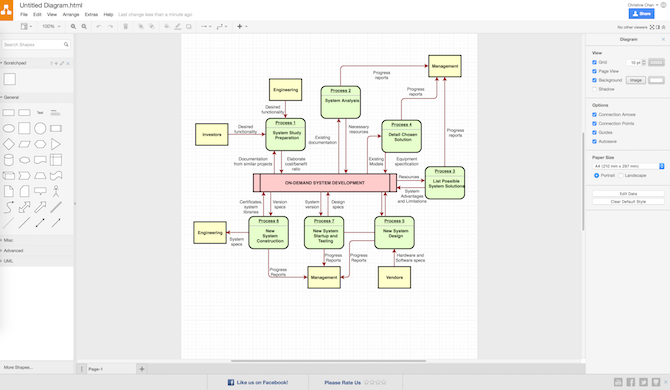
daw.io fits the bill for anyone looking for a completely free flowchart solution.
There’s no account to sign up for with draw.io. All you need to do to get started is choose your storage space, which gets remembered for later. Options include Google Drive, Dropbox, OneDrive, and local storage. If you need collaboration with others, Google Drive is the best choice since draw.io leverages Google Drive’s collaboration features.
Once you pick your storage space option, you can then make a new flowchart diagram from scratch, or use a template from the ones provided. There are only five flowchart templates to pick from (while Lucidchart has over 10 templates). There are other non-flowchart diagram templates if you need them.
If draw.io has the kind of flowchart you need, then go for it. You can add shapes, arrows, and other objects from the side menu just by dropping it in. Everything’s fairly straightforward with draw.io, though it’s not as intuitive or streamlined as Lucidchart.
draw.io supports file imports, and you can import from JPEG, PNG, SVG, Gliffy, Lucidchart, and VSDX. Diagrams you create with draw.io get saved or exported as HTML, JPEG, PDF, PNG, SVG, and XML.
Unlike a lot of the other options, draw.io is completely free with no option for paid accounts. It has a somewhat limited feature set and isn’t as good as other tools, but you can’t beat the price of free.
3. Cacoo
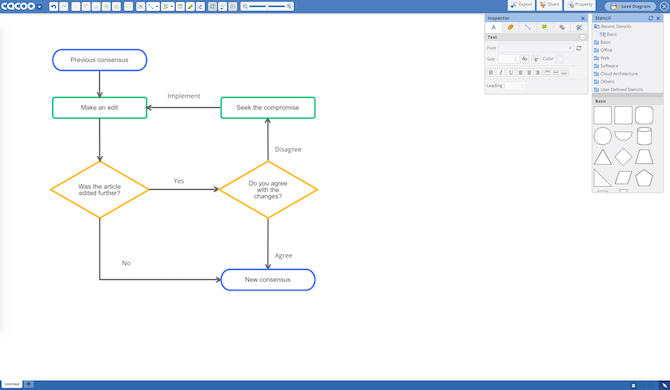
If real-time collaboration is a requirement for your online flowchart maker, then Cacoo has the others beat.
Much like Lucidchart, Cacoo comes with a super streamlined and fluid interface that’s pleasant on the eyes. Cacoo comes with a multitude of templates for your project, whether it’s flowcharts, wireframes, Venn diagrams, and a rich variety of other diagrams. For flowcharts, Cacoo has an extensive range of shapes to choose from, no matter the type of project. And everything’s done through simple drag-and-drop.
The best feature of Cacoo is the real-time collaboration. Multiple people on your team can work on the flowchart at once. Also, there’s a chat feature so you can see and comment on changes as they happen. And since things can get a bit complicated with multiple people working on one document at the same time, Cacoo provides memo fields so you can keep track of who’s involved.
Cacoo seems built with teams in mind, which you clearly see with their project folders and security settings for members. Cacoo’s still great for single users, as you get storage for 1000 sheets, unlimited sharing, SVG import and export, and more.
The pricing for Cacoo is reasonable enough. Single users can get a plan starting at $4.95 per month, and then there’s the Team level starting at $18 per month for three users (and they go up from there). The Enterprise level allows you to install Cacoo on your own private server, and that starts at $600 a year for 10 users. All account levels come with a 14-day free trial.
4. Gliffy
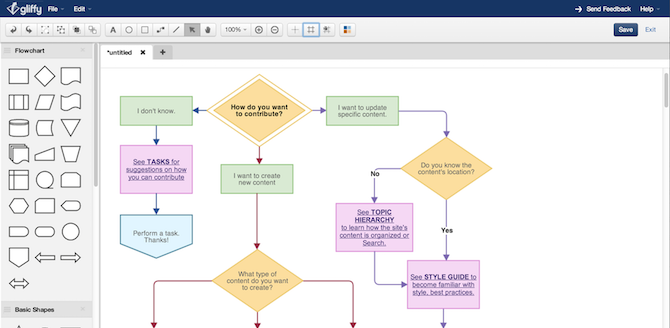
In the moments when you just need a simple and lightweight tool for the job, consider Gliffy.
Compared to the other services, Gliffy is a bit more barebones. It’s a good option when you need to flowchart an idea quickly and easily.
You can create any flowchart in just a few clicks. There are basic templates available that make it even easier to reach your final product. However, when you start to get down and fine-tune your flowcharts, the editing process is not as smooth as others, like Lucidchart. There are a few quirks that may slow you down a bit, but snap-on grids and other alignment tools are nice to have.
As an HTML5 cloud app, it can work offline too. And when you need to collaborate, Gliffy provides ways to share and even invite others to view, edit, or leave comments, but the collaboration isn’t as powerful as other flowcharting tools.
Gliffy offers plans starting at $7.99 per month for single users, and a team plan for $4.99 per month, both billed annually. For enterprise users, it includes everything in the team plan, but with even more security and features.
5. Wireflow
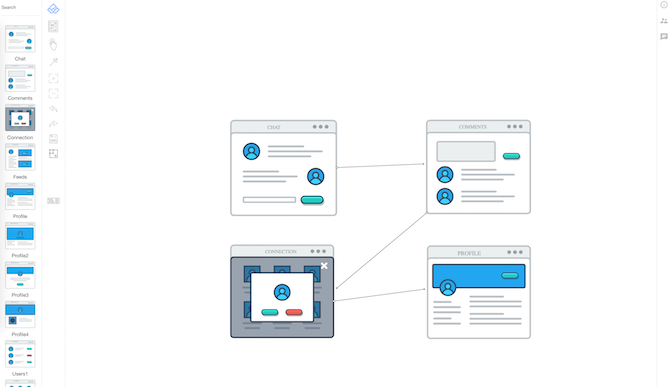
Another completely free option for your consideration is Wireflow. It is the perfect tool for web developers and app designers.
Wireflow is a beautiful flowchart tool for designing user flows and wireframes. A pretty and intuitive interface offers a variety of different chart designs, that you can drag-and-drop onto a fresh canvas. There are many connectors to choose from, and everything’s manageable through drag-and-drop.
When you’re done creating your diagram, you can export the final product as a JPG. This is the biggest drawback of Wireflow, as you’re unable to pick a different format. Again, it’s free to use with no options for paid plans, so that’s expected. There’s also quite a lot of scrolling involved since there are so many different chart types to go through.
If all you need are to create flowcharts to demonstrate user flows for software, then Wireflow gets the job done.
6. Textographo
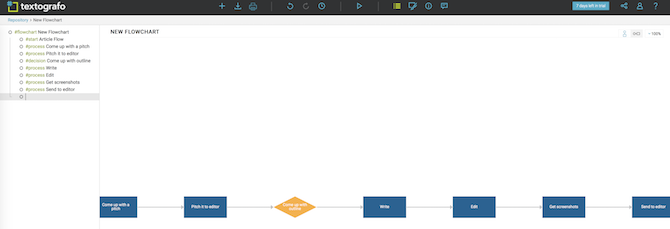
Need to create flowcharts but don’t want to deal with the finicky positioning of shape objects and arrows? Then Textographo is for you.
Textographo is a unique flowchart tool that uses text. All the user needs to do is type out their chart in a specific text syntax that uses hashtags, keywords, and some markup. Textographo takes this text and turns it into static and animated diagrams that include flowcharts, mindmaps, organizational charts, decision trees, and much more.
Once you’ve got the text laid out, Textographo automatically gets to work and organizes everything into diagram form. It’s super easy, intuitive, and streamlined. Users may also customize it by choosing a theme they like or changing the layout to something else that better suits their needs.
Since Textographo saves all documents in their cloud, you’re able to collaborate with your team by inviting them to view, give feedback, and share ideas.
There are two account levels for Textographo: Essentials and Premium. Essentials starts at $8 per month if billed annually, or $12 per month. Premium costs $14 per month annually, or $19 per month. Considering the distinctive and convenient system Textographo uses, the cost is fairly reasonable.
7. Google Drawings
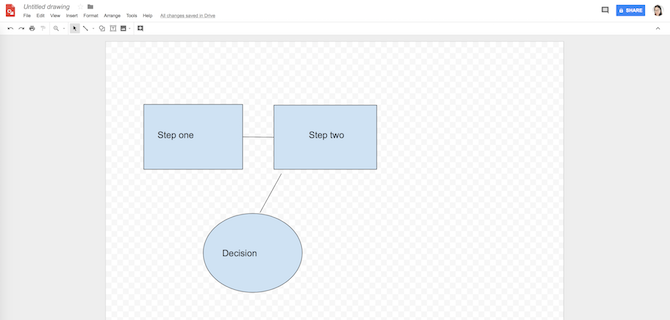
If you’re already using a Google account, then there’s a free option that’s already been available to you: Google Drawings.
In order to access Google Drawings, you’ll first need to get to your Google Drive. Then just click Create New and choose Google Drawings under the More option.
Use the extensive shapes in Google Drawings. Add basic shapes, arrows, callouts, and even equation symbols to your blank canvas. You move everything around through simple drag-and-drop, and you can resize and rotate as needed.
And since Google Drawings is through Google Drive, sharing and collaborating is no problem. Just invite others through email, and give them permissions to view, edit, or comment. You’re able to export your flowchart as an image file or SVG, or you could even publish it to the web.
Google Drawings is free to use since it’s through your Google account, where you get 15GB of free storage across all Google apps. The storage space can get upgraded to 100GB, 1TB, or 10TB for $1.99, $9.99, or $99.99 per month, respectively.
The Best Solution for Visual Brainstorming
Flowcharts are an incredibly powerful tool. They lay out complex processes into a much more simple and easy to understand manner, and complicated projects don’t seem so scary anymore.We’ve just discussed the best options for online-only flowchart services—some are completely free, and others offer just free trials of their premium plans. But like everything in life, you get what you pay for. That’s why we prefer Lucidchart when making flowcharts online.
Source: https://www.makeuseof.com/tag/free-online-flowchart-makers/




